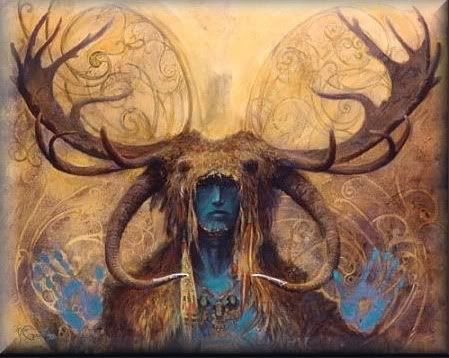I first met Cernunnos deep in the Forest of Dean, alone and within a forest glade with the sun filtering down through thee gently rustling leaves, the humming insects but most of all the silence…and there He was! Some might say he was merely a mirage, a spark of my imagination but to me He was, and is, as real as you or I.
Who is Cernunnos? Well, popularly he is A Gaulish god associated with the stag and all hoofed animals, a god of fertility. abundance and the wild. He is probably best known from his image on the Gundestrup Cauldron, found in Denmark, and dating from between 200 BC and 300 AD. But scholars now believe that the name ‘Cernunnos’ doesn’t necessarily refer to one particular god but probably was a name given to many tribal gods that had similar characteristics in an attempt to ‘nationalize’ these gods under one name during Roman rule.
The name ‘Cernunnos’ is now generally believed to be derived from the proto-Indo-European root *krno, which also gives us the Gallic cernon, the Welsh carn, the Latin cornu and the Germanic *hurnaz, all of which mean ‘horn’. We can also see this root in words such as cornucopia and coronet (a small crown). As I’ve mentioned the most dramatic representation of Cernunnos appears on the Gundestrup Cauldron. Here he is seen sitting cross-legged, or crouching, holding a ram-headed serpent in one hand and a torc in the other, he also wears a torc himself and is surrounded by wild animals, including the wolf and the stag. Regarding his sitting position, many have believed that this rather buddha-like position suggests he is a god derived from the far East but when you think about the way the ancient Celts habitually sat we can see that this is merely a representation of their culture. Classical writers reported that the ancient Celtic Gauls did not sit on seats but were to be found sitting on the ground, either in a crouching position or cross-legged. The ram-headed serpent he holds aloft is of special significance as serpents were a symbol of fire coming from the earth; rebirth and renewal (note also that snakes shed their skins in entirety annually) and hibernate during the winter months and then become active again during the spring, thus seen as ‘coming alive’ again. Ram-headed serpents were always seen as symbols of chthonic wisdom and transformation. The torcs were always a sign of power and leadership in Celtic culture, so wearing one and also holding one shows us that Cernunnos was someone of great power and leadership. Leadership over whom? Well the fact that he is surrounded by wild animals gives us a good clue. Generally seen as a god ruling the wild spaces, and animals.
 However, there is more to Cernunnos than just a fertility god. In fact he has more to do with hunting, culling, and purification through selection and sacrifice than fertility. He is equated with Herne the Hunter, great lord of Windsor Park who takes the spirits of the dead to the Underworld in what is known as ‘The Wild Hunt’, and also Gwyn ap Nudd and Arawn, who in the Mabinogion is the Lord of Annwn, the Underworld. Moreover, the Romans equated him with Dis Pater, not only a god of abundance but also god of death. So Cernunnos has mastery over the energies of nature but is also what is known as a psychopomp, a gate-keeper god who has province over leading souls of the dead to the underworld.
However, there is more to Cernunnos than just a fertility god. In fact he has more to do with hunting, culling, and purification through selection and sacrifice than fertility. He is equated with Herne the Hunter, great lord of Windsor Park who takes the spirits of the dead to the Underworld in what is known as ‘The Wild Hunt’, and also Gwyn ap Nudd and Arawn, who in the Mabinogion is the Lord of Annwn, the Underworld. Moreover, the Romans equated him with Dis Pater, not only a god of abundance but also god of death. So Cernunnos has mastery over the energies of nature but is also what is known as a psychopomp, a gate-keeper god who has province over leading souls of the dead to the underworld.So what about my experience with Cernunnos? Well it moved me to write a poem in his honour as he has become one of my patron deities.
At the edge of the glade
In liminal places,
Arms branch out, feathered leaves
Rustling in a soft breeze….
Softly green merging with space
Antlers garlanded with grace,
and ‘Who am I?’ written on his face.
A question? Or a statement?
My heart flutters, my soul sings…
Poised on a moment of eternity,
All is within and without.
Was it a voice in my head?
An aching echo of a long distant past?
‘Know me’ he said,
‘Embrace me’ he echoed down the halls of emptiness.
My soul reaches out…
Out into the space, into the trees, into the leaves,
With green and golden tints.
Swallowed up by the coolness of dew,
The musky odour of hide,
The moist earthiness.
And we were one
Cernunnos and I.
Written by Deep Glade
References
Celtic Gods & Goddesses by R.J. Stewart
Horns of Power: Manifestations of the Horned God by David Rankine
Magic of the Celtic Gods & Goddesses by Carl McColman & Kathryn Hinds
.


Excellent poem. To meet the Horned One in somewhere like the Forest of Dean would be a very special experience indeed. It is a beautiful forest indeed.
ReplyDeleteI think so too. I just noticed and made a connection with something here. Cernunnos was, in part, a god of hunting. The Jägermeister label displays a horned stag with a Christian cross, and is supposed to reflect two patron saints of hunting. It seems that the actual origin was really Cernic.
Delete~Have a Heathen day!~